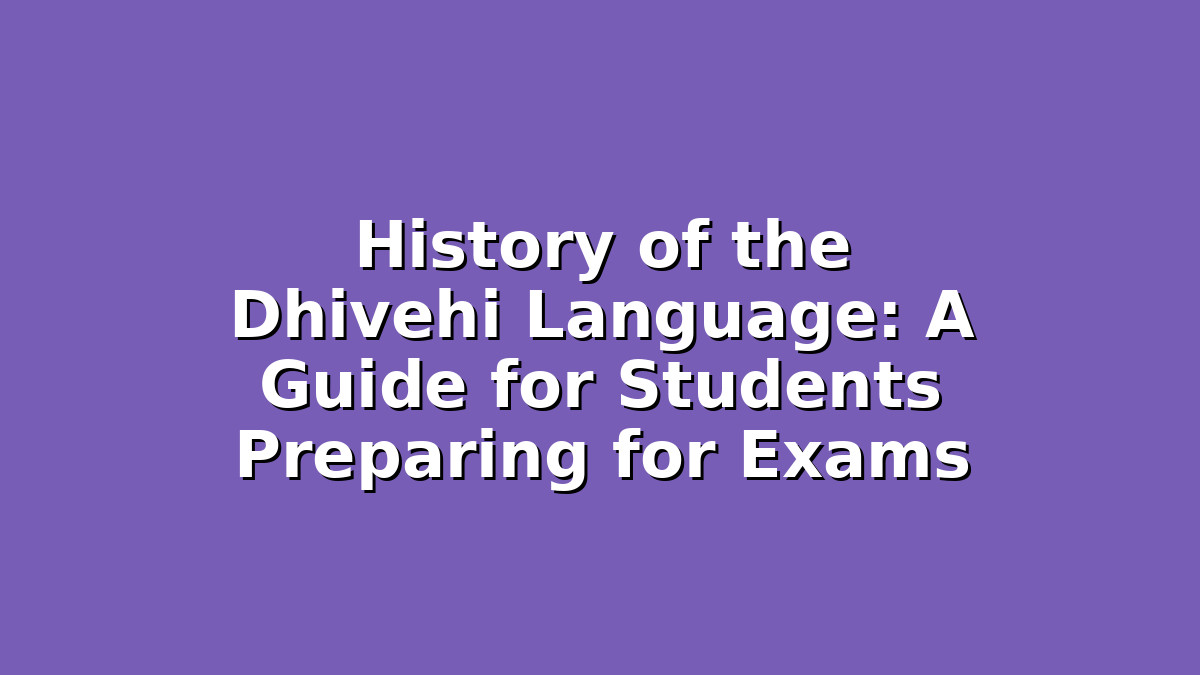Introduction
If you are a student preparing for exams that include the Dhivehi language or Maldivian culture, understanding the history of Dhivehi is essential. Not only will it strengthen your knowledge base, but it will also give you cultural insights that can make your answers stand out. Dhivehi, the official language of the Maldives, has a rich and fascinating history intertwined with the Indian Ocean’s diverse cultures. In this article, we will explore the origins and evolution of the Dhivehi language, its script development, and its modern-day usage. Along the way, you’ll find practical study tips to help you master this topic efficiently and confidently.
Section 1: Origins and Evolution of the Dhivehi Language
Dhivehi is an Indo-Aryan language, believed to have descended from the Elu Prakrit, an ancient language spoken in Sri Lanka. Historical evidence suggests that Dhivehi began to take shape over 1,500 years ago when settlers from the Indian subcontinent and Sri Lanka migrated to the Maldives. This migration led to the adaptation of local dialects influenced by neighboring languages such as Sinhala and Tamil.
Studying Tip:
When approaching this section for exams, create a timeline highlighting key periods in Dhivehi’s development—like its connection to Elu Prakrit and early influences from other languages. Flashcards can be especially helpful here. Write down important terms such as “Elu Prakrit,” “Indo-Aryan language family,” and “historical migration” along with brief definitions. Reviewing these cards regularly will reinforce your memory and prepare you for essay questions or multiple-choice quizzes.
Section 2: The Development of Dhivehi Script – From Abugida to Thaana
One of the most interesting aspects of Dhivehi’s history is the evolution of its writing system. Originally, Dhivehi was written using the “Divehi Akuru” script, an ancient form of writing derived from Brahmi scripts used across South Asia. Divehi Akuru was in use until the 18th century but gradually gave way to the Thaana script, which is unique to the Maldives.
Thaana script is a fascinating script because it is written from right to left, similar to Arabic, and incorporates elements of Arabic numerals and indigenous innovations. The name “Thaana” is said to be derived from the first letters of the script, and its creation reflects the Maldives’ Islamic cultural influence. Today, Thaana remains the primary script used for writing Dhivehi.
Studying Tip:
To grasp the significance of the scripts, try comparing Divehi Akuru and Thaana using visual aids. Drawing out the alphabets and practicing writing simple words will help you internalize the script’s structure. Additionally, understanding the cultural context—how Islam influenced the adoption of Thaana—can help contextualize your answers. Group study sessions where you quiz each other on script characteristics can make learning fun and interactive.
Section 3: Modern Use of Dhivehi and Its Role in Maldivian Identity
In modern times, Dhivehi serves as a symbol of Maldivian national identity and unity. It is spoken by nearly everyone in the Maldives and is used in government, education, media, and daily communication. Despite the Maldives’ exposure to global languages like English, Dhivehi remains the mother tongue and a crucial part of the country’s heritage.
Educational reforms have emphasized Dhivehi literacy, and there are many resources available for students studying the language. Additionally, the government promotes Dhivehi literature, poetry, and traditional storytelling, which helps keep the language vibrant and relevant.
Studying Tip:
When preparing for exams, explore contemporary uses of Dhivehi by reading current newspapers, listening to Maldivian radio programs, or watching television shows in Dhivehi. This exposure will improve your comprehension and provide real-world examples to reference in essays. Also, consider writing short essays or summaries in Dhivehi to practice language skills and demonstrate your proficiency.
Conclusion
Understanding the history of the Dhivehi language offers more than just academic knowledge; it connects you to the Maldives’ rich cultural and linguistic heritage. By studying its origins, script evolution, and modern-day significance, you can approach your exams with confidence and depth. Remember to use study techniques such as timelines, flashcards, visual aids, and real-world exposure to enhance your learning experience. Stay curious, keep practicing, and embrace the story of Dhivehi—it will not only help you succeed in your exams but also foster a deeper appreciation for this beautiful language.

Responses